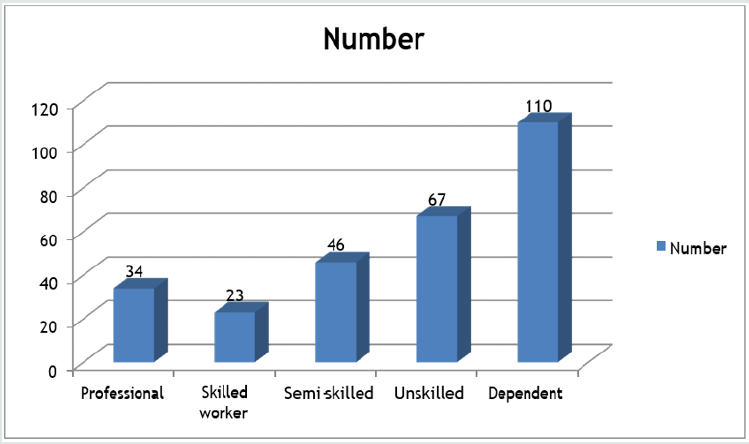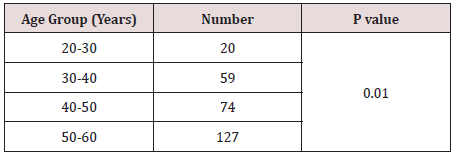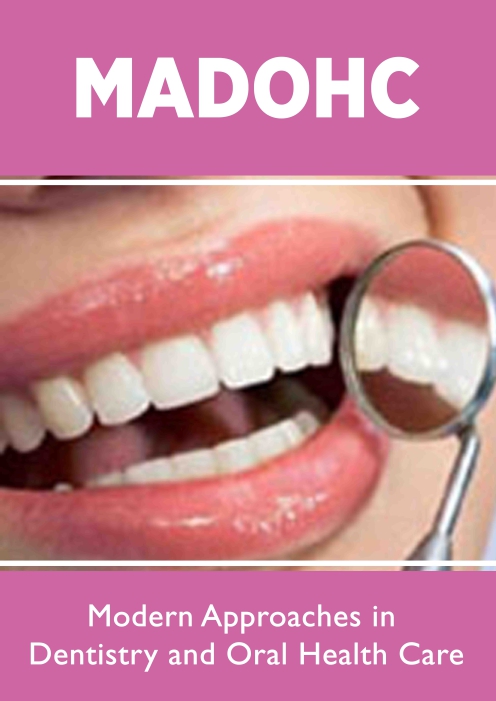
Lupine Publishers Group
Lupine Publishers
Menu
ISSN: 2637-4692
Short Communication(ISSN: 2637-4692) 
To Assess Socio- Demographic Distribution of Patients with Fixed Prostheses Running Title: Fixed Prostheses Volume 4 - Issue 2
Ashish Pandey*, Saurabh Dhanraj Yadav and Kanika Manral
- Department of Prosthodontics, Daswani Dental College & Research Centre, India
Received: January 01, 2020; Published: January 08, 2020
Corresponding author:Ashish Pandey, Department of Prosthodontics, Daswani Dental College & Research Centre, Kota, Rajasthan, India
DOI: 10.32474/MADOHC.2020.04.000183
Abstract
Background: Total or partial edentulism is a good indicator of the oral health of a population. The present study was conducted to assess socio-demographic distribution of patients with fixed prostheses.
Materials & Methods:
The present study was conducted on 280 patients of fixed prostheses. Five socioeconomic groups: professionals and managerial officers and retirees of this type, skilled Workers, Semi-skilled Workers, Unskilled workers and dependents were assessed.Results: Age group 20-30 years had 20, 30-40 years had 59, 40-50 years had 74 and 50-60 years had 127 patients. 110 patients were dependent, 67 were unskilled, 46 were semi-skilled, 34 were professional and 23 were skilled workers. The difference was significant (P<0.05). Fixed prostheses were seen in both anterior and posterior teeth in 112 cases, anterior in 110 cases and posterior in 58 cases. The difference was non- significant (P>0.05).
Conclusion: Authors found that fixed prostheses were commonly among dependents followed by unskilled and semi-skilled workers.
Keywords: Fixed prostheses; Socio- demographic; Semi-skilled
Introduction
Total or partial edentulism is a good indicator of the oral
health of a population. The prevalence and extent of tooth loss
has decreased significantly in many developed countries during
recent decades. Some studies have reported that the incidence of
edentulism correlates with educational level and income status,
with those in lower levels exhibiting higher risks of becoming
totally edentulous [1].
Dental prosthesis could either be fixed or removable. It has been
postulated that socio- demographic characteristics influencing the
prevalence of dental restorations varies from country to country.
This variability may be influenced by ability to afford this type
of treatment, accessibility of treatment and attitudes toward it.
Although a high proportion of individuals require some sort of
dental prosthesis, treatment involving the use of dental prosthesis
is infrequent in developing countries. Social and geographical
variations in dental prosthetic replacement may be associated with
differences in both patients’ and dentists’ attitudes towards oral
health as well as socioeconomic status [2].
The general requirements of dental prostheses are obvious
from the goal of prosthodontics. Thus, the most important aim of
restoration is to rehabilitate oral function, especially the masticatory
function [3]. It means that the individual geometry of the dental
prostheses is needed to establish appropriate and efficient occlusal
contacts. For example, the detailed characteristics of the cusps of
the posterior artificial tooth, like the cuspal inclination, height,
and geometry, should match those of the opposite fossa. Then, the
two opposite posterior teeth should form a pestle-and-mortarlike
structure that is efficient for grinding food [4]. The present
study was conducted to assess socio- demographic distribution of
patients with fixed prostheses.
Materials & Methods
The present study was conducted in the department of prosthodontics. It comprised of 280 patients of fixed prostheses. The study protocol was approved from institutional ethical committee. All patients were informed regarding the study and written consent was obtained. Data such as name, age, gender etc. was recorded. Five socioeconomic groups: professionals and managerial officers and retirees of this type, skilled Workers, Semiskilled Workers, Unskilled workers and dependents were assessed. Results were tabulated and subjected to statistical analysis. P value <0.05 was considered significant.
Results
Table 1 shows that age group 20-30 years had 20, 30-40 years had 59, 40-50 years had 74 and 50-60 years had 127 patients. Table 2 & Figure 1 shows that 110 patients were dependent, 67 were unskilled, 46 were semi-skilled, 34 were professional and 23 were skilled workers. The difference was significant (P< 0.05). Table 3 shows that fixed prostheses were seen in both anterior and posterior teeth in 112 cases, anterior in 110 cases and posterior in 58 cases. The difference was non- significant (P>0.05).
Discussion
Prosthodontics pertains to the diagnosis, treatment planning, rehabilitation, and maintenance of oral function, comfort, appearance, and health of patients with clinical conditions associated with missing or deficient teeth, and/or maxillofacial tissues using biocompatible substitutes. The subject highlighted in this chapter is special prostheses for tooth and dentition [5]. Fixed dental prostheses are treatment/restorations for the replacement of missing tooth structure, teeth, or oral tissues. The general requirements of dental prostheses are obvious from the goal of prosthodontics. Thus, the most important aim of restoration is to rehabilitate oral function, especially the masticatory function [6]. It means that the individual geometry of the dental prostheses is needed to establish appropriate and efficient occlusal contacts. For example, the detailed characteristics of the cusps of the posterior artificial tooth, like the cuspal inclination, height, and geometry, should match those of the opposite fossa. Then, the two opposite posterior teeth should form a pestle-and-mortar-like structure that is efficient for grinding food [7]. The present study was conducted to assess socio- demographic distribution of patients with fixed prostheses.
In present study, age group 20-30 years had 20, 30-40 years had 59, 40-50 years had 74 and 50- 60 years had 127 patients. Enabulele & Omo [8] included a total of 256 patient records for the study. The patients’ age ranged from 18 to 83 years with a mean age of 38.86±15.86 years. There was a decline in number of patients who received fixed prosthesis as age increased with those ≤30 years of age recording the highest frequency. Skilled workers accounted for the majority (35.2%) of the patients while dependent and professionals accounted for 32.0% and 22.7% respectively. More than half (52.0%) of the patients were married. A higher proportion of females had crowns provided for them while a higher proportion of males had fixed partial denture provided for them and this was statistically significant.
We found that 110 patients were dependent, 67 were unskilled, 46 were semi-skilled, 34 were professional and 23 were skilled workers. Fixed prostheses were seen in both anterior and posterior teeth in 112 cases, anterior in 110 cases and posterior in 58 cases. Aesthetics is one of the reasons why missing tooth parts and teeth are replaced. This becomes imperative and foremost when the tooth to receive the prostheses is an anterior tooth which is prominent during smiling and speech. The anterior teeth represent one’s personality, presentation, carriage and aesthetics when compared to the posterior teeth. Hence, more than half of the patients had anterior fixed prostheses treatment done [9].
Baran et al. [10] conducted a study in which 510 partially and/ or totally edentulous patients were studied using a questionnaire. The questionnaire consisted of questions; age, gender, education level, income status, problems with dentures, necessity for new dentures. Also asked was the place that the subjects would prefer to get their denture treatment, irrespective of their income level. The number of male patients with complete dentures was more than the number of females, with an opposing trend for partial dentures. Irrespective of gender, each patient had had nearly two dentures by the time of questioning. It was also observed that the university clinics were generally preferred by patients from higher income levels with a higher educational level (x2=25.206, P<.00). When patients were asked where they would prefer denture treatment, regardless of cost, private practice was the preferred choice.
Conclusion
Authors found that fixed prostheses were commonly among dependents followed by unskilled and semi-skilled workers.
References
- Marcus SE, Drury T, Brown LJ, Zion GR (1996) Tooth retention and tooth loss in the permanent dentition of adults: United States 1988-1991. J Dent Res75:684-695.
- Iacopino AM, Wathen WF (1993) Geriatric prosthodontics: an overview. Part I. Pretreatment considerations. Quintessence Int24(4):259-266.
- Manji F, Baelum V, Fejerskov O (1988) Tooth mortality in an adult rural population in Kenya. J Dent Res67(2):4496-4500.
- Lin HC, Cobet EF, Lo ECM, Zhang HG (2001) Tooth loss, occluding pairs, and prosthetic status of Chinese adults. J Dent Res. 80(5):1491-1495.
- Susin C, Oppermann RV, Haugejorden O, Albandar JM (2005) Tooth loss and associated risk indicators in an urban population from south Brazil. Acta OdontolScand63(2):85-93.
- Österberg T, Carlsson GE, Sundh W, Fyhrlund A (1995) Prognosis and factors associated with dental status in the adult Swedish population. Community Dent Oral Epidemiol23(4):232-236.
- Marcus PA, Joshi A, Judith AJ, Morgano SM (1996) Complete edentulism and denture use for elders in New England. J Prosthet Dent76(3):260-266.
- Enabulele JE, Omo J (2018) Socio-demographic distribution of patients with fixed dental prosthesis in a developing economy. PeriodonProsthodon4(1):06.
- Iacopino AM, Wathen WF (1993) Geriatric prosthodontics: an overview. Part II. Treatment considerations. Quintessence Int24(5):353-361.
- Baran İ, Ergün G, Semiz M (2007) Socio-demographic and economic factors affecting the acceptance of removable dentures. Eur J Dent1(2):104-110.

Top Editors
-

Mark E Smith
Bio chemistry
University of Texas Medical Branch, USA -

Lawrence A Presley
Department of Criminal Justice
Liberty University, USA -

Thomas W Miller
Department of Psychiatry
University of Kentucky, USA -

Gjumrakch Aliev
Department of Medicine
Gally International Biomedical Research & Consulting LLC, USA -

Christopher Bryant
Department of Urbanisation and Agricultural
Montreal university, USA -

Robert William Frare
Oral & Maxillofacial Pathology
New York University, USA -

Rudolph Modesto Navari
Gastroenterology and Hepatology
University of Alabama, UK -

Andrew Hague
Department of Medicine
Universities of Bradford, UK -

George Gregory Buttigieg
Maltese College of Obstetrics and Gynaecology, Europe -

Chen-Hsiung Yeh
Oncology
Circulogene Theranostics, England -
.png)
Emilio Bucio-Carrillo
Radiation Chemistry
National University of Mexico, USA -
.jpg)
Casey J Grenier
Analytical Chemistry
Wentworth Institute of Technology, USA -
Hany Atalah
Minimally Invasive Surgery
Mercer University school of Medicine, USA -

Abu-Hussein Muhamad
Pediatric Dentistry
University of Athens , Greece

The annual scholar awards from Lupine Publishers honor a selected number Read More...








